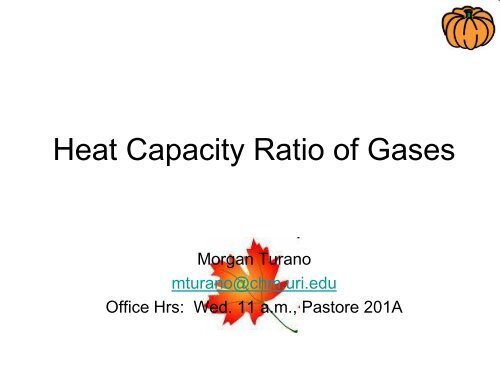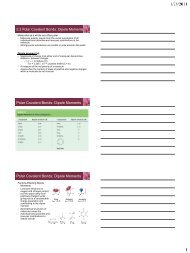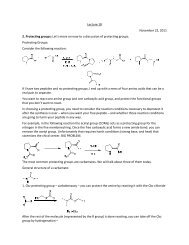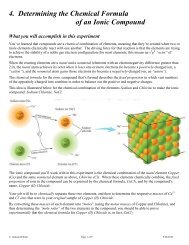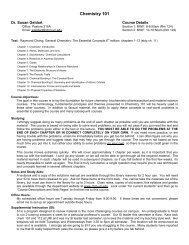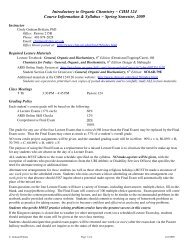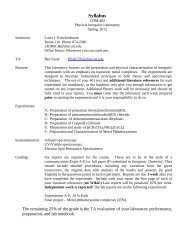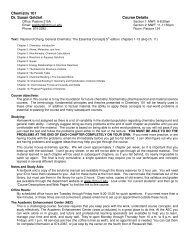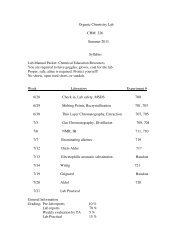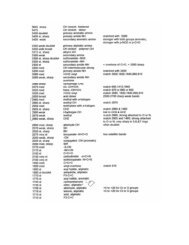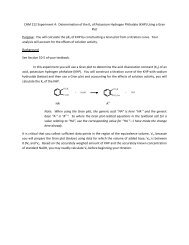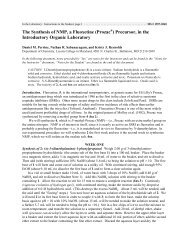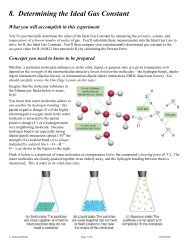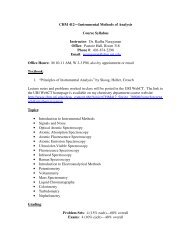Experiment 3 Heat Capacity Ratio of Gases
Experiment 3 Heat Capacity Ratio of Gases
Experiment 3 Heat Capacity Ratio of Gases
You also want an ePaper? Increase the reach of your titles
YUMPU automatically turns print PDFs into web optimized ePapers that Google loves.
<strong>Heat</strong> <strong>Capacity</strong> <strong>Ratio</strong> <strong>of</strong> <strong>Gases</strong><br />
Morgan Turano<br />
mturano@chm.uri.edu<br />
Office Hrs: Wed. 11 a.m., Pastore 201A
Purpose<br />
To determine the heat capacity ratio for<br />
monatomic and diatomic gases.<br />
To understand and mathematically<br />
model reversible & irreversible adiabatic<br />
processes for ideal gases.<br />
To practice to propagate error for<br />
complex functions.
Key Physical Concepts<br />
<strong>Heat</strong> capacity is the ratio <strong>of</strong> heat input/output to<br />
temperature change in a substance<br />
C = dq / dT<br />
Where C = heat capacity, dq = change in heat,<br />
dT = change in Temp.<br />
And is defined as: γ = CP/ CV<br />
Where:<br />
CP = (∂H / ∂T)P<br />
CV = (∂U / ∂T)V<br />
Adiabatic processes occur when no heat is<br />
exchanged between the system and the<br />
surroundings (i.e. q=0)
Theory: Energy<br />
Energy <strong>of</strong> gaseous molecules can be defined<br />
as translational (ET), rotational (ER), or<br />
vibrational (EV)<br />
ETOT = ET + ER + EV<br />
ET = (3RT)/2<br />
ER = DRT/2 (D = 2 or 3)<br />
EV = 3N – ET – ER<br />
Where N = number <strong>of</strong> atoms, R = gas constant,<br />
T = temperature, 3N = total degrees <strong>of</strong> freedom,<br />
D = number <strong>of</strong> possible dimensional rotations
Theory: <strong>Heat</strong> <strong>Capacity</strong><br />
<strong>Heat</strong> <strong>Capacity</strong> (const. V): CV = (∂U / ∂T)V<br />
Monatomic: CV = 3R/2<br />
Diatomic: CV = 5R/2<br />
<strong>Heat</strong> <strong>Capacity</strong> <strong>Ratio</strong>:<br />
CP = CV + R<br />
γ = CP / CV = 1 + (R/CV)<br />
Reversible: γ = [ln(P1 / P2)] / [ln(P1 / P3)]<br />
Irreversible: γ = [(P1 / P2) – 1] / [(P1 / P3) – 1]<br />
The more molecular motions…<br />
The greater the heat distribution<br />
Therefore diatomic heat capacity > monatomic heat<br />
capacity
Theory: Determination <strong>of</strong><br />
<strong>Heat</strong> <strong>Capacity</strong> <strong>Ratio</strong><br />
To determine heat capacity ratio, we will<br />
subject a gas to an adiabatic expansion and<br />
then allow the gas to return to its original<br />
temperature via an isovolumetric process, during<br />
which time it will cool.<br />
In the above processes, three states <strong>of</strong> the gas<br />
will be examined:<br />
Before expansion: P1, V1, T1, n1<br />
Immediately after expansion: P2, V2, T2, n1<br />
After returning to room temperature: P3, V2, T1, n1<br />
This expansion and warming can be modeled<br />
two different ways.
Reversible Expansion<br />
(Textbook)<br />
Assume that pressure in carboy (P1) and<br />
exterior pressure (P2) are always close enough<br />
that entire process is always in equilibrium<br />
Since system is in equilibrium, each step must<br />
be reversible<br />
Can generate smooth, well behaved analytical<br />
functions from equation <strong>of</strong> state
Irreversible Expansion<br />
(Lab Manual)<br />
Assume that pressure in carboy (P1) and<br />
exterior pressure (P2) are not close enough;<br />
there is sudden deviation in pressure; the<br />
system is not in equilibrium<br />
Since system is not in equilibrium, it is not<br />
possible to generate continuous functions<br />
The equation <strong>of</strong> state is only valid at endpoints<br />
and must be evaluated as such
Part I: <strong>Experiment</strong>al Procedure<br />
1) Set up apparatus, insert rubber stopper.<br />
2) Open tubes A & B, attach C to manometer.<br />
a) For Argon, attach A to Argon tank (input line).<br />
Leave tube B open (output line).<br />
b) For Nitrogen, attach B to Nitrogen tank (input line).<br />
Leave tube A open (output line)<br />
3) Allow gas to flow into carboy at 15 mbar for 15<br />
minutes. Close the gas.<br />
4) Close output line. Slowly open the gas a<br />
small amount; hold down stopper.<br />
5) When manometer reaches 60 mbar, turn <strong>of</strong>f<br />
gas. Manometer reading is now constant.<br />
6) Record manometer reading (Man1).
Part I: <strong>Experiment</strong>al Procedure<br />
7) Remove stopper 2-3” and replace tightly as<br />
quickly as possible. Hold down stopper.<br />
8) Record manometer reading (Man2).<br />
9) Record manometer reading again when<br />
manometer reading is constant (Man3).<br />
10) Repeat steps 2 - 9 for a total <strong>of</strong> six<br />
measurements (three for Ar, three for N2).<br />
-- Between runs <strong>of</strong> the same gas flush (step 3) for only 3 minutes.<br />
Between different gasses flush for 15 minutes. Why?<br />
11) Record lab temperature.<br />
12) Record lab barometric pressure.
Part I: <strong>Experiment</strong>al Procedure<br />
Use<br />
line A to<br />
input Ar,<br />
which reaches<br />
the bottom <strong>of</strong><br />
the carboy.<br />
Use<br />
line B to<br />
input N2,<br />
which does<br />
not reach the<br />
bottom <strong>of</strong> the<br />
carboy.<br />
Set Up <strong>of</strong> Apparatus<br />
Argon<br />
manometer<br />
http://itl.chem.ufl.edu/4411L_f00/gamma/eq14.gif
Part II: Data Analysis<br />
P1 = Man1 + Barometer<br />
P2 = Man2 + Barometer<br />
P3 = Man3 + Barometer<br />
Reversible: γ = [ln(P1 / P2)] / [ln(P1 / P3)]<br />
Irreversible: γ = [(P1 / P2) – 1] / [(P1 / P3) – 1]
Part III: Laboratory Report<br />
Title Page: Title, name, partner(s), date <strong>of</strong><br />
experiment.<br />
Abstract: One (1) paragraph <strong>of</strong> what, why, how<br />
and results.<br />
Introduction: Discussion <strong>of</strong> purpose and<br />
general nature <strong>of</strong> experiment, derive equations.<br />
Theory: State all assumptions, define all<br />
variables, give variations on formulas.<br />
Discuss both reversible & irreversible adiabatic<br />
expansion, and the difference between them.<br />
Explain which you think closest resembles this<br />
experiment.<br />
Procedure & Original Data: Both signed.<br />
Results: Data tabulated in order <strong>of</strong> calculations<br />
that follow.
Part III: Laboratory Report<br />
Calculations: (SHOW ALL WORK)<br />
For each trial, determine γ for both reversible and<br />
irreversible expressions.<br />
Include at least one sample calculation <strong>of</strong> each type<br />
<strong>of</strong> calculation used in numerical analysis.<br />
Error Analysis: (SHOW ALL WORK)<br />
Assume error <strong>of</strong> ±2 in the last recorded figure <strong>of</strong><br />
manometer and barometer.<br />
Report γ as the average <strong>of</strong> all trials for each gas and<br />
each expression.<br />
Choose only one trial to propagate error in γ for each<br />
expression; be sure to identify which trial is used.<br />
Propagate errors in each pressure to obtain error in γ.<br />
Compute expressions for statistical error in γ for both<br />
reversible and irreversible processes.
Part III: Lab Report<br />
Error Analysis (Cont’d)<br />
Propagate error in each <strong>of</strong> the following:<br />
P1 = Man1 + Barometer<br />
P2 = Man2 + Barometer<br />
P3 = Man3 + Barometer<br />
Reversible: γ = [ln(P1 / P2)] / [ln(P1 / P3)]<br />
Irreversible: γ = [(P1 / P2) – 1] / [(P1 / P3) – 1]
Part III: Laboratory Report<br />
Summary <strong>of</strong> Data: Report all values with error<br />
and determine (with math) the best value (rev. or<br />
irrev.) <strong>of</strong> the average γ & determined error in γ.<br />
Conclusions:<br />
Discuss significance <strong>of</strong> results. Do they match<br />
hypothesis/expectations?<br />
Compare γ±ε(γ) for both reversible and irreversible<br />
expansions. Do the two values lie within their<br />
respective statistical errors?<br />
Compare γ±ε(γ) with the expected values for a<br />
monatomic and diatomic gas. Do the theoretical<br />
results lie outside the experimental errors? If so,<br />
discuss possible reasons for the lack <strong>of</strong> agreement.<br />
Suggest how experiment might be improved.
Important Reminders<br />
Use line A for Argon input<br />
Use line B for N2 input<br />
Make sure one partner is holding<br />
stopper tightly in carboy from time = 0s.<br />
When calculating pressures, add<br />
manometer readings with barometric<br />
pressure <strong>of</strong> room.<br />
TA will only sign data AFTER you have<br />
turned <strong>of</strong>f the gases.<br />
www.parenting.leehansen.com<br />
www.pumpkin-clipart.com


